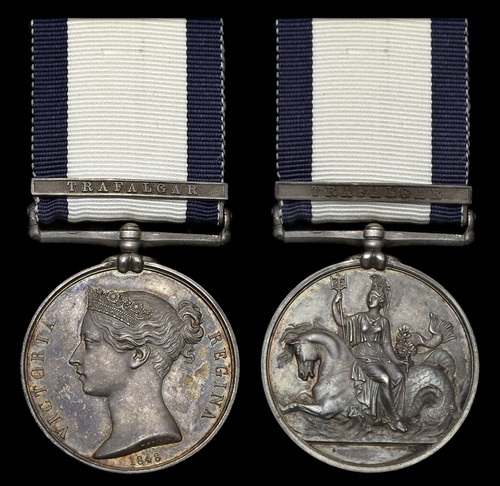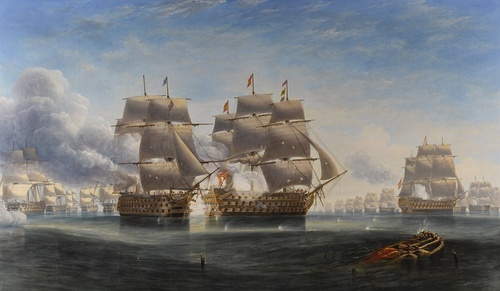Auction: 25001 - Orders, Decorations and Medals
Lot: 111
(x) 'Now, gentlemen, let us do something today which the world may talk of hereafter!
Thus spoke Rear-Admiral Cuthbert Collingwood from the deck of his flagship, H.M.S. Royal Sovereign, prior to the Battle of Trafalgar
The Naval General Service Medal awarded to Able Seaman E. Kendall, Royal Navy
Naval General Service 1793-1840, 1 clasp, Trafalgar (Edward Kendall.), good very fine
Provenance:
Seaby, June 1953.
Spink, December 1972.
Edward Kendall was born in London around 1778 and was 27 years old when he served as an Able Seaman aboard the H.M.S. Royal Sovereign during the Battle of Trafalgar.
Royal Sovereign was a 100-gun first rate ship of line and was launched at Plymouth in 1786, over a decade after she was laid down in 1774, and was the only ship built to her specific design. Reportedly slow and difficult to manoeuvre, she was nicknamed the 'West Country Wagon' by her crew.
Prior to serving at the famed Battle of Trafalgar, Royal Sovereign enjoyed an active role during the French Revolutionary Wars. She served as part of Admiral Richard Howe's fleet during the Glorious First of June, the first fleet action of the War, where she was the flagship of Admiral Thomas Graves' vanguard squadron. This resounding tactical victory saw Admiral Howe issue the unorthodox order for his ships to turn and breach the French line, rake the enemy ships and engage them directly. Royal Sovereign pulled too far into the line and suffered a heavy pounding from enemy ship Terrible, with Admiral Graves mortally wounded and dying during the course of the battle. Terrible fell out of the line and Royal Sovereign next engaged Montagne. Seven enemy ships were sunk or captured but the British lost none.
Now the flagship of Vice-Admiral William Cornwallis, Royal Sovereign was further engaged in the conflict known as 'Cornwallis' Retreat'. In June 1795, a French fleet of twelve ships of the line and eleven frigates gave chase to Cornwallis' squadron of five ships of the line and two frigates. After a day's chase the rearguard came within range of the enemy, and rather than abandon part of his squadron Cornwallis stood his ground to counterattack with all his might. The Vice-Admiral steered Royal Sovereign in between the French and British forces, meeting the enemy with a raking fire. The Battle ended when French Admiral Villaret de Joyeuse mistakenly believed the British Channel Fleet was approaching and subsequently ordered his fleet to withdraw, thus allowing Cornwallis to escape.
Royal Sovereign was further involved in a notable altercation on 17 March 1796 when the transport ship Bellisarius collided with her while en route to the West Indies and sank almost instantly.
The Battle of Trafalgar
H.M.S. Royal Sovereign held the distinction of being flagship of Vice-Admiral Collingwood, Rear-Admiral Horatio Nelson's second-in-command at that famous sea battle off the coast of Trafalgar, Spain on 21 October 1805. She led one column of warships during the conflict while Nelson led the other, and was the first ship of the fleet to enter the action.
Recently re-coppered, Royal Sovereign was faster than the other ships present and was the first to break the enemy line in accordance with Nelson's unorthodox plan to approach the allied line with his fleet arranged in two columns, which would cut the allied line and force one-on-one fighting.
As Royal Sovereign gallantly sailed alone towards the enemy and made to engage the massive Spanish three decker Santa Ana, Collingwood remarked to his Captain, Edward Rotheram, "What would Nelson give to be here?". At roughly the same time, his friend Nelson reportedly pointed to her and exclaimed, "See how that noble fellow Collingwood carries his ship into action!".
Collingwood's well-trained crew aboard Royal Sovereign fired such a rapid volley at Santa Ana that four allied ships quickly came to her aid, with Royal Sovereign first receiving fire from Fougueux before being joined by Indomptable, San Justo, and San Leandro. Despite this assistance, Santa Ana suffered nearly 240 casualties and struck her colours to Royal Sovereign at 2:20 that afternoon.
Hemmed in at all sides by the enemy, Royal Sovereign suffered significant damage before she could be relieved by the remainder of the British fleet. She had lost her mizzen and main masts, most of her rigging, and suffered damage to her foremast and was no longer manoeuvrable. Even so, she continued to fire at the enemy from her port-side guns. Collingwood himself also suffered a wound to his leg whilst on deck, but was lucky in that he was only one of three officers on her quarterdeck who lived to see the end of the Battle.
Following the death of Nelson at around 4:30pm, Collingwood assumed command of the fleet as commander-in-chief. Collingwood removed to H.M.S. Euryalus as a consequence of Royal Sovereign being, in his words, "perfectly unmanageable" after sustaining too much damage to continue as flagship. While Nelson's final command prior to his death had been for the fleet to anchor in advance of an oncoming gale, Collingwood disagreed and focused on those vessels still able to anchor and survive the storm. He had Royal Sovereign towed away while she was still able to stay afloat. She sustained 141 casualties over the course of the Battle.
After Trafalgar
Following the battle, missing her mizzen and mainmasts and most of her rigging, Royal Sovereign returned to Plymouth to be repaired and refitted. She thereafter returned to duty as part of the Mediterranean Fleet and participated in the ongoing blockade of Toulon. In November 1811 she was ordered to join the Channel Fleet, later being converted to harbour service as a receiving ship. Renamed Captain in 1825, she was eventually broken up at Plymouth in 1841. Four of her cannons were incorporated into the Collingwood Memorial in Tynemouth, where they may be seen to this day.
Little is known about the fate of Kendall aside from his service at Trafalgar, only that he is confirmed on the roll as serving with Royal Sovereign during the battle and that he lived to claim his medal; sold together with copied medal roll.
Subject to 5% tax on Hammer Price in addition to 20% VAT on Buyer’s Premium.
Estimate
£4,000 to £6,000
Starting price
£3200







